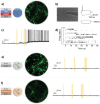Photo-Chemical Stimulation of Neurons with Organic Semiconductors
- PMID: 37661572
- PMCID: PMC10625067
- DOI: 10.1002/advs.202300473
Photo-Chemical Stimulation of Neurons with Organic Semiconductors
Abstract
Recent advances in light-responsive materials enabled the development of devices that can wirelessly activate tissue with light. Here it is shown that solution-processed organic heterojunctions can stimulate the activity of primary neurons at low intensities of light via photochemical reactions. The p-type semiconducting polymer PDCBT and the n-type semiconducting small molecule ITIC (a non-fullerene acceptor) are coated on glass supports, forming a p-n junction with high photosensitivity. Patch clamp measurements show that low-intensity white light is converted into a cue that triggers action potentials in primary cortical neurons. The study shows that neat organic semiconducting p-n bilayers can exchange photogenerated charges with oxygen and other chemical compounds in cell culture conditions. Through several controlled experimental conditions, photo-capacitive, photo-thermal, and direct hydrogen peroxide effects on neural function are excluded, with photochemical delivery being the possible mechanism. The profound advantages of low-intensity photo-chemical intervention with neuron electrophysiology pave the way for developing wireless light-based therapy based on emerging organic semiconductors.
Keywords: non-fullerene acceptors; organic bioelectronics; photo-stimulation.
© 2023 The Authors. Advanced Science published by Wiley-VCH GmbH.
Conflict of interest statement
The authors declare no conflict of interest.
Figures





References
-
- Chan W.‐M., Lam D. S. C., Lai T. Y. Y., Liu D. T. L., Li K. K. W., Yao Y., Wong T.‐H., Ophthalmology 2004, 111, 1576. - PubMed
-
- Maya‐Vetencourt J. F., Ghezzi D., Antognazza M. R., Colombo E., Mete M., Feyen P., Desii A., Buschiazzo A., Di Paolo M., Di Marco S., Ticconi F., Emionite L., Shmal D., Marini C., Donelli I., Freddi G., Maccarone R., Bisti S., Sambuceti G., Pertile G., Lanzani G., Benfenati F., Nat. Mater. 2017, 16, 681. - PMC - PubMed
MeSH terms
Substances
Grants and funding
LinkOut - more resources
Full Text Sources
